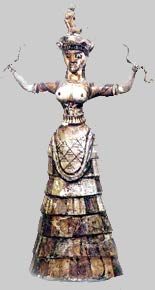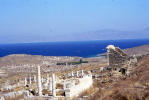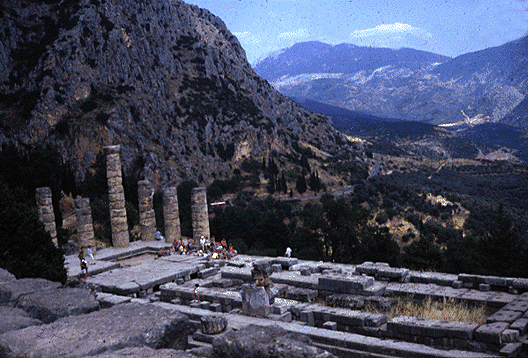|
Disclaimer: This unedited, rough draft material is a year-long project in response to our 2004 theme: pilgrimage. It is meant to be a dialogue between myself and my fellow Mammoths and any of you who happen along. It is intentionally not polished, nor is it finished. Charlie Buchman Ellis --------------------------------------------------------------------------------
Tracy Chevalier has a neat gimmick going.
She imagines the story behind famous works of art and writes an
entire historical novel to buttress her imaginative work.
I got hooked on her with the story of the famous Unicorn
tapestries, a work I grew to love during frequent visits to NYC in the
late 80’s and early 90’s. They
hang, all of them I think, in the Cloisters, one of my ten favorite
spots on God’s green earth.
These tapestries are wonderful; to see them in the context of these monastic buildings, with period music played in the courtyard, is one of life’s pleasures, and I’ve not experienced it in some time. Her book about them has put me firmly back in the middle ages, a time I find appealing from a religious and aesthetic perspective, so long as I can stand on this side of public sanitation and modern medical care to admire it. The religious perspective I admire is the confidence of the laity in such popular religiosity as Mary, reliquaries, feast days, and the hours of prayer during the day. By the way, this last point jiggled my Islamic work—5 prayer times a day, not so distant really, since some Catholics, especially monastics, have even more.
The Metropolitan Museum of Art
Let me see...I’m not sure I’m clear here. The kind of religiosity marked by popular appeal, the bane of theologians and dogmaticians since at least Plato, represents an attempt to express the religion of the heart. This religion of the heart appears in every religious tradition: the Pure Land sects of Buddhism with Amida’s instant salvation, the worship of Ganesh among Hindus, even, in a sense the hadith in Islam, the Kabbalah in Judaism...and so on. This popular religion is, I believe, less true in its specifics, and more true in its general inclination than any of the so-called major religions. I believe this for a number of reasons:
Here we return, for a moment, to the Ricoeur idea of second naiveté. If you can no longer claim a religiosity of the heart, then, somehow, you must travel through the intricate web of concepts, rules, and strong, oh so strong, cultural inculcations you have received to find that still, small spot where the sacred can speak to you. And here is the problem. As a person convinced by the Jungian perspective on the psyche (at least in part), I believe in the dark gods who rule us from within. You know them, the demon of melancholia, the god of parents past, the nymph of lust, and many others, a vast polytheistic pantheon. If not a god, then what do you call a power who can reach into your very soul and change its direction, make you do things you do not want to do, make you repeat actions you’ve done before and know to be destructive? Read either Hollis or Hillman’s Revisioning Psychology. They both give good voice to this line of thinking. If you don’t engage the sacred, push through the skepticism and the pain and the fear to a spot where you can draw nourishment from the sacred within—the sacred source that supports you, gives you power, helps you grow in the direction most powerful for you and the world around you, then you will be slave to the dark gods, a vassal unable to make independent decisions. Of course. You’re right; we have both vassal and saint within us, and at times the gods take control of us, and at times we are one with the inner springs, the holy wells over which the cathedral of the Self is built. Yes, it’s true, we all have the vassal in us, and we all have the pilgrim nature, the impetus toward Self and the sacred. I’m happy we have this emphasis on pilgrimage this year, because our inner pilgrim needs all the help he or she can get.
Just a quick note to capture Sara for the diary. Blue eyeliner, ruby red lipstick, clover stockings, hot pink and black shoes (with sparkles in them). She smiled; she reached out to touch; she kept attending to our needs (wants). She captivated me and I wanted to say so here, so we can recall her later, as part of our journey. I hope we decide to invite Gyatsho to join the Woolly’s. I like him and find his experience and perspective complementary to ours. He would liven the pot, give us a new way of seeing ourselves. We might, literally, have to help him financially sometimes—for retreats, meals out—I don’t know his exact financial situation, but I believe it’s spare. His wife works as a waitress and their apartment, though neat and very Tibetan, is not in a high rent building. I think the pilgrimage to the last dwelling place of so many adolescent male mammoths sounds like a hoot. I hope my schedule allows it. I have the Jungian seminar again, second weekend, and I’m preaching at Groveland on the 19th and have a drawing intensive that whole weekend. Who knew September would prove so busy? A quick note here, too, to capture a thought that has tumbled through several times in the last week. I grew up in a farming belt, my great-uncles and aunts and my grandparents all had farms or were raised on one, and a few of my cousins are on farms still. So, I have blood connection to the soil and had farmer friends, even though my family never farmed nor did we ever live in the country. This rural ethos has an impact on my current neo-paganism, I’m sure. There is, however, another side to where I grew up: factories. Central Indiana is a manufacturing region, filled with automobile factories, factories making thermos bottles, rock-wool insulation and ceiling tiles, Ball-dome canning jars, and even, art glass for the stained glass industry (as Mark told me.) I worked in factories: shipping clerk for Johns-Manville in a rock-wool plant in Alexandria, in a ceiling tile factory in Joliet, Illinois, and in a paper-mill in Appleton, Wisconsin. Most of my male classmates expected to go straight from high school to the floor of Delco Remy or Guide Lamp (batteries, alternators, and head lights for G.M.) where they would work 30 and out. Most of my female classmates expected to marry the factory workers. At some point kids, house, a cabin somewhere in Michigan, a boat, then retirement and death. A pattern I saw often as I grew up. A factory and a farm seem very different, yet the attempt to bend reality to fit the demands of human technique dominates both. Especially as farms have mechanized their distinction from factory floors has grown less and less. I’m not sure why this is on my mind just now, but it is, and it has a hard edge to it, no softness, and little spiritually redeeming value. Yet there is some deep social justice involved. More later. A couple of more notes about das Schwarzwald. Betty Bundle and the lottery winner. Gift certificates to Cub, hiding lottery winners at the Hinckley Casino. Where does Mark get all this stuff anyhow? Scott’s 90 days to make a million and only 83 days left. The Chicago Book Expo and a sense of shame and guilt, but, still, deciding to go on the ride anyhow. CNS, they say, is good for colds and gold. Warren’s Shakespearean drama with the mother-in-law who wants to remain in the family homestead, and whose senile dementia causes her to forget her friends and the small, easy to navigate apartment when she returns home from the place her husband wants to live. And, of course, Sheryl and Warren on the side of Dad and getting in a smaller space, easier to handle for him and mom; the sister, siding with Mom, willing to move in with her to let her stay in the home she knows. The sister convinced Sheryl and Warren want mom out so they can get the house; the sister needing a place to live with her out of work beau. If not Shakespeare, at least Days of our Lives. Paul’s work on the center at the Cathedral of St. Mark. A possible job offer there. Working with a labor lawyer and setting up his own H.R. consulting business. The runes saying transformation in the wind, a time of change. Viva la lucha! Tom’s incredulity at the “science” in Day After Tomorrow. I mean, Florida’s still there!? And the giant hurricanes and sucking cold air down from the troposphere or wherever. Tom, a former NOAA employee, knows whereof he speaks. I hope he’ll write in and correct my understanding of climate change. Mark and William have suggested an evening focused on pilgrimage’s past, one’s we’ve already taken. I have so many. I’ll mention one, a minor one in some ways. This pilgrimage developed as I did what I always do before I travel: read. After Kate’s hand-surgery three years ago or so, she needed a break while her hands recovered. She loves cruises (I’ve come to love them, too.) and she picked a Holland-America cruise through the Aegean Sea. I was lukewarm about the destination because I’ve done a couple of cruises and know the brief, been there seen that, weigh anchor, next port, shore excursion rhythm and it didn’t feel adequate for the wine-dark sea. I began to read. I re-read the Odyssey and the Iliad. I dipped into Bullfinch and Hamilton and Burke. I listened to lectures on Greek civilization and Greek literature. The Delian league began to interest me; it was a sacerdotal empire similar to Rome, its headquarters on Delos, a small island just off Mykonos, the island destination of the jet set in the 1960’s. Apollo and Aphrodite were born on Delos. Hmmm... The Delian league was strong and many of its member states took matters of policy to Delphi (Dell-fee, I learned.) to hear from the oracle. I also had an interest in the Sacred Wars, though I knew little about them. On this trip we would have the opportunity to see Capri (from which Tiberius ruled Rome.), Crete (birthplace of Zeus and home to Knossos), Santorini (whose crescent shape is the result of a vast volcanic explosion long considered the cause of Cretan decline—a theory now discredited.), Delos and Mykonos, Athens or Delphi, the Turkish coastal city of Kusadasi and the ancient city of Ephesus, cruise past the Hellespont and up the Dardanelles, with a final stop in Istanbul. The closer the trip came, the more and more it felt like a calling, places I no longer wanted to see, but needed to see; sites I no longer imagined as distant wonders, but destinations. Cruising allows one pleasure and denies another; it allows a leisurely elegant pace and the serenity of the ocean, it denies the back roads and small villages, the chance encounter. This is true at least of the cruising Kate and I have done, more expensive, lengthier cruises do allow for more onshore time. So we set out for Rome and Leonard Da Vinci airport. Due to a bus strike—a common event in Italy—we traveled to Civitavecchi, Rome’s ancient port, by taxicab. I did not know at the time that taxi driving over distance in Italy had grown into a motor sport, but, as our drivers gamely attempted to outrace each other the 40 or so miles through the lovely countryside, I learned from experience. Yikes! Anyhow. We got there and embarked. The next day we made the port in Naples and went by water taxi to Capri. Glorious, but not a spot for pilgrimage, though, in a way it had some pilgrimage resonance because my mother was stationed in Naples during WWII and vacationed in Capri.
Again, not pilgrimage destinations for me on this trip, yet...the names and the history associated with each of them marked for me the true beginning of the pilgrimage, after we rounded the boot of Italy we entered the Ionian sea, from which we would reach the Aegean.
These were, for this pilgrimage, places to begin sinking deeper into the reality of the Aegean, the wine-dark sea, and its islands, but not places to stop.
I had two destinations for my pilgrimage: Delphi and Delos.
Delos and Delphi
The Temple of Apollo, beneath which the Delphic Oracle sat on a tripod stool, breathing vapors from the earth herself. We went to Delphi first, boarding a bus in the ancient (everything’s ancient at one remove or another here.) Athenian port city of Piraeus. Since I was young, 6 or 7, I’ve had a fascination with myth and legend. This bus ride, an ordinary enough bus, one of those coach style tour buses with very high seats, took us first out of the port area then into an area where street signs made it clear Athens—the Athens—was nearby. Our guide pointed out the Parthenon and the Acropolis as we went past; they were far off, but visible. We could have gone there instead of Delphi, but I wanted to see Delphi. Along the side of the road, our guide pointed small shrines, “For people who have died here.” Like our own crosses, pictures, balloons, but these were wooden chapels with Orthodox crosses and pictures of the Holy Mother and Orthodox Saints. This, the guide said, as we paid a toll, is the plain of Marathon. 26 miles he ran, only to collapse and die. Marathon. Not long after we passed the famous intersection where Oedipus met his fate. Not far from there, Thebes sat on a hill, and had we driven up the hill, we could have the Gulf of Corinth and Corinth herself, instead our eyes now saw Mt. Parnassus. Fabled mountain. Storied. A place I never thought to see in this lifetime, or in reality, this reality or any another. Yet there it was. Craggy, pine flecked, enshrouded by low-lying clouds, as it often is, a clear sight, even a relatively clear one as the one we had this day a rare thing. And somewhere hidden on its flanks, the sacred city of Delphi. Site of temples and treasuries, the Sibyl, the Delphic Oracle, an amphitheatre, and the prominence from which Greeks were flung in capital punishment. We wound through small villages and finally came to an upscale ski town, host to the winter visitors to Mt. Parnassus. The bus squeezed through narrow streets. I’m going to finish this in the next posting...I want to talk about Delphi and Delos in a little more depth than I can sustain right now.
Paid for my ticket to Singapore and out of Bangkok today. I leave on October 26 and come back November 26th. This felt like the true beginning of the journey itself, acquiring transportation and committing to a certain time. Now I can focus even more on what I want to see, my drawing lessons, and the task of taking as little as possible with me.
Thanks for sharing my pilgrimage with me.
Until next week.
|
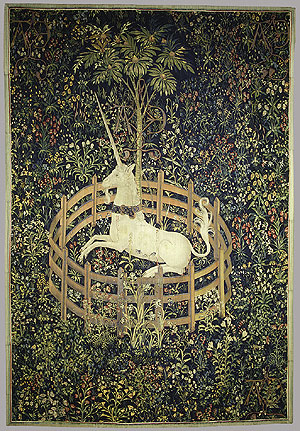
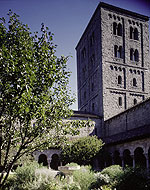
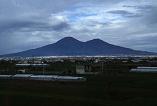 Vesuvius is
across the bay, and later that night, we passed Stromboli (remember
Pinocchio?), and then, even later as we threaded the strait of
Vesuvius is
across the bay, and later that night, we passed Stromboli (remember
Pinocchio?), and then, even later as we threaded the strait of 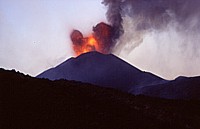 To touch, even from the distance of the deck, the
waters sailed by Greeks of legend and history took me firmly into the
space of pilgrim, albeit, I admit, a very comfortable pilgrim.
To touch, even from the distance of the deck, the
waters sailed by Greeks of legend and history took me firmly into the
space of pilgrim, albeit, I admit, a very comfortable pilgrim. The stops at Crete and Santorini were like stops at
inns along the road, interesting sights and wonderful geography:
The stops at Crete and Santorini were like stops at
inns along the road, interesting sights and wonderful geography: